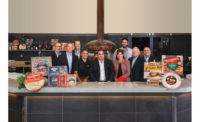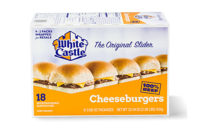How Palermo's slices through the sea of sameness
Palermo Villa’s 250,000-square-foot, BRC Grade A manufacturing facility in Milwaukee, Wis., boasts state-of-the-art equipment and world-class food safety ratings.

Frozen pizzas travel in a single file into a 250-foot-long packaging line situated on the other side of the freezer. Click here to see more photos of the tour!
When first arriving at Villa Palermo, it’s easy to second guess the location. Instead of encountering an industrial park, smoke stacks and a dozen or so trucks, one sees a quaint, picturesque replica of a 16th century Italian villa. That’s because Palermo’s manufacturing facility is attached to its company headquarters in Milwaukee, Wis., and its on-site restaurant, Pizzeria 3301, which offers custom-made pizzas, a fresh salad bar, refreshments, Italian gifts and of course, freezers full of Palermo’s brand pizzas.
On the other side of the building sits the manufacturing facility, which houses four frozen lines that produce finished pizzas, and two bakery lines—one frozen and one refrigerated— that process pizza crusts for the Palermo’s, Screamin’ Sicilian and Pmo’s brands.
But, it’s not just the Italian flair and attention to detail that named Palermo Villa, Inc. as Refrigerated & Frozen Foods’ 2016 Frozen Foods Processor of the Year.
“Speed and innovation are key traits that make Palermo’s different from others in the category,” says Giacomo Fallucca, president and CEO, and one of three sons of founders Gaspare (“Jack”) Fallucca and his wife, Providenza (Zina). “Whether branded or private label, we can quickly turn concepts into successful new products.”
Take a tour of this 250,000-square-foot, BRC Grade A facility to find out how state-of-the-art equipment, world-class food safety ratings and great employees help this restaurant operator turned frozen foods processor slice through the sea of sameness.
Making room for more pizza
In 2009-2010, Palermo’s Milwaukee facility underwent a 115,000-square-foot expansion. Today, the plant encompasses a high-tech pizza manufacturing operation, on-site bakery and 24-hour shipping and receiving, says Angelo Fallucca, chief operating officer.
“The expansion provided space for additional pizza topping lines, as well as space for additional material storage and future bakery capabilities,” he adds. “It also provided for greatly enhanced employee service areas such as human resources, cafeteria and relaxation space and more.”
Palermo’s two bakeries run six days a week, 24 hours a day, shutting down one day a week for sanitation and maintenance. The four production lines run either two, 10-hour shifts a day for four days, shutting down for a 4-hour sanitation window each day, or 24 hours a day for four days, shutting down for 8 hours for sanitation and maintenance.
“In the coming year, we are planning to transition all of our lines to continuous 24-hour production, staffed by three crews running eight hours per shift,” says Milt Fuehrer, executive vice president of operations.
Safety, sustainability come first
Palermo’s abides by a safety-first culture, which includes:
- Monthly safety and quality training.
- Twice-monthly huddles to discuss best practices.
- Safety-spotter audits conducted every two hours on all lines.
- Fully trained first responder team.
- On-site medical professionals for work-related and personal needs.
- Workplace stretching program prior to the start of all shifts.
- Ergonomics program that focuses on body mechanics and physical improvements.
- Injury trend evaluation to improve/enhance overall safety efforts.
“We’re proud that our safety training programs exceed regulatory requirements, and that our injury and lost-time statistics rank us better than industry averages,” says Angelo.
Palermo’s also meets or surpasses all government regulatory standards for cleanliness and food safety, adds Fuehrer. In fact, the BRC Grade A, GFSI- and organic-certified facility maintains an extensive environmental and waste reduction program.
For instance, much of the company’s retail branded product is handled through Palermo’s direct-store delivery distribution network in the Midwest, with the remainder shipped through its four distribution centers. Meanwhile, Palermo’s private label products ship via truck in truckload or less than truckload (LTL). And, Palermo’s is currently restructuring its distribution network to eliminate long-haul, LTL shipments from its central distribution network.
“Our main initiative for 2017 is adapting our supply chain to our expanding LTL business,” adds Fuehrer. “This will involve opening a regional distribution facility to act as our hub-and-spoke network, which will enable us to continue expanding into new markets and still maintain profitability.”
Plus, Palermo’s is recognized as a Smartway-certified shipper, and helps to reduce greenhouse gas emissions by utilizing freight carriers certified for their fuel-efficient practices.
Another component to improving the company’s environmental footprint is energy conservation. That’s why the Milwaukee headquarters offices are outfitted with occupancy sensors, and the manufacturing plant uses energy efficient LED lighting.
Likewise, Palermo’s turns more than 400 tons of food waste into repurposed feed for livestock. The more than 3 million pounds of cardboard used annually for master boxes and individual pizza boxes is made from recycled pulp. And, Palermo’s recycles more than 600 tons of cardboard and plastic annually, along with thousands of plastic drums.
“Additional efforts focus on water conservation, land beautification and partnering with environmentally friendly organizations,” says Fuehrer.
How innovation drives production
At the time of Refrigerated & Frozen Foods’ visit, Palermo’s was producing 12-inch Screamin’ Sicilian Mambo Italiano frozen pizzas. (For more on this new line and other new products, go to How Palermo's Delivers A Little Slice of Italy).
The process begins in the facility’s downstairs bakery (the upstairs bakery is dedicated for the thinner crust pizzas). Flour is brought in pneumatically through a 4- vault carousel system, which adds ingredients, then mixes, then adds other inclusions, then mixes again.
Dough balls proceed to the proofer, which proofs 1,200 dough balls at once through a 16-minute cycle. Product then travels in four rows into a cross-sheeted system, which is a cookie cutter-like machine that cuts and shapes the dough. Sensors on the machine help keep the dough in alignment and determine the shape of the crust. After the dough gets docked and hole punched, the machine applies a bit of oil on the surface to help it breathe and expand.
“All the crusts that we make on site are used right here in the facility,” says Chad Larson, plant manager. “This bakery and Line 4 were part of the expansion.”
The process time from the dough ball system to the oven is about 20 minutes. Dough cooks in a stone-hearth oven for 60 seconds at 550°F, resulting in a par-baked crust, which then travels on a 4-wide conveyor into a blast freezer. After freezing, crusts are placed on the toppings line, where sauce spouts deposit the sauce. The spouts, which look like free fall-style shower heads, deposit sauce at the appropriate times according to the sensors, while a line operator manually checks each crust.
Then, the crust passes through up to three waterfalls, each tasked with applying cheeses, meats or vegetables. At the time of Refrigerated & Frozen Foods’ visit, the waterfalls dropped meatballs, rough-chopped pepperoni and cheese, which comes in blocks and is shredded fresh on site.
The pizzas travel along a conveyor, where toppings are compressed and excess toppings recirculate to be used on other pizzas.
All processing lines feature a pre-melter, which melts the cheeses and meats ever so slightly, locking the toppings in place before pizza goes into a freezer, says Larson.
From the pre-melter, the pizzas convey into the spiral freezer for about 20 minutes at -20°F, in which they are frozen solid, and then travel in a single file from a row of four conveyors into a 250-foot-long packaging line situated on the other side of the freezer.
Here, a flow wrapper overwraps the pizzas with plastic wrap that shrinks with heat. Sensors situated inside a control arm control the speed at which the pizzas travel through the machine. Meanwhile, another machine automatically places the cardboard and slides it underneath the pizzas before passing through a shrink tunnel for 15 seconds. The shrink tunnel heats the product a bit, so bubbles in the wrapping can pull down tight against the pizza and keep toppings locked in place. Then, an inkjet printer applies code dates to the pizza wrapping and the box, before another machine folds the flaps of the pizza boxes up and glues them closed around the pizza.
The facility has the capacity to produce more than 130 million pizzas a year.
“We have been a family-owned company for more than 50 years, and one of our core beliefs is that when we win, we win with our consumers, customers and employees,” says Giacomo. “This award recognizes our beliefs and the success we’ve experienced by creating innovative products, strong retail partnerships and brands that truly connect with all our consumers.”
Looking for a reprint of this article?
From high-res PDFs to custom plaques, order your copy today!






